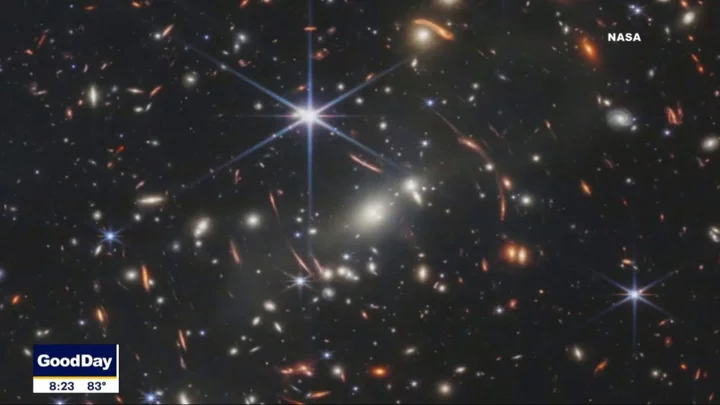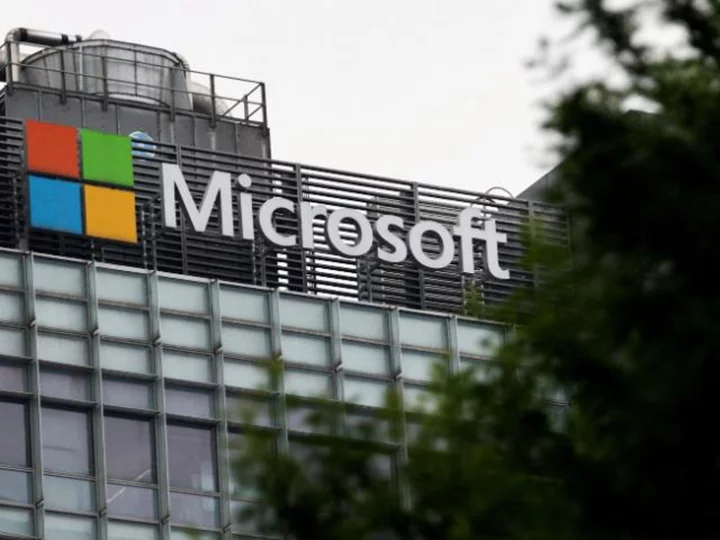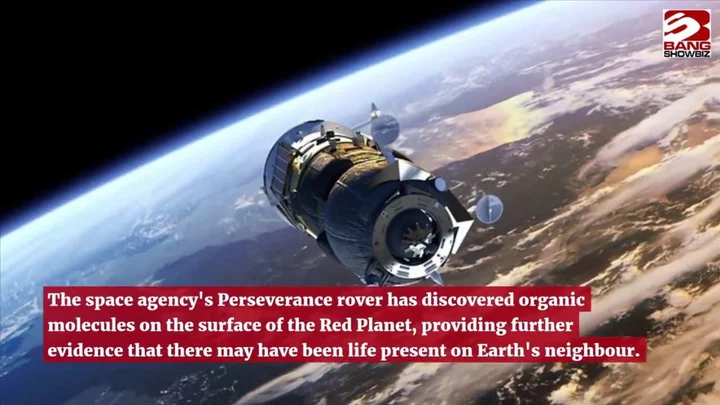
Xi calls for 'solid' security barrier around China's internet
BEIJING Chinese President Xi Jinping said China must build a "solid" security barrier around its internet under the
2023-07-15 20:55

Nasa just uncovered mysterious new type of star ‘powered by dark matter’
A mysterious new set of stars has been detected by Nasa’s James Webb Space Telescope, which could shed new light on dark matter. Dark matter remains one of the most hotly debated elements in our solar system, and the new objects could change the way it is studied. Scientists believe the huge, newly-discovered stars are powered by illusive dark matter and shared their findings in the journal PNAS. “Discovering a new type of star is pretty interesting all by itself, but discovering it’s dark matter that’s powering this – that would be huge,” said study co-author Katherine Freese from The University of Texas in Austin. Sign up to our free Indy100 weekly newsletter The dark stars, known as JADES-GS-z13-0, JADES-GS-z12-0 and JADES-GS-z11-0 – were first identified as galaxies last December. It’s thought that they existed about 320-400 million years after the Big Bang, making them some of the earliest objects ever seen. The nature of dark matter continues to fascinate and mystify the scientific community. It’s believed that it could be formed by a new type of undiscovered particle, and the theorised component of the universe does not absorb, reflect or emit light. It’s also thought that suspected dark stars like these could explain a potential anomaly surrounding the number of large galaxies in the early universe. Currently, there are too many to fit the predictions of the theories surrounding the origins and the future of the universe. “It’s more likely that something within the standard model [of cosmology] needs tuning, because proposing something entirely new, as we did, is always less probable,” Dr Freese said. “But if some of these objects that look like early galaxies are actually dark stars, the simulations of galaxy formation agree better with observations,” she explained. Have your say in our news democracy. Click the upvote icon at the top of the page to help raise this article through the indy100 rankings.
2023-07-15 19:19

AI facial recognition tech brings 'airport-style security' to UK stores, says human rights group
A rising number of British stores are using a facial recognition system powered by artificial intelligence to identify repeat shoplifters in what one human rights group has called the spread of "airport-style security" on the high street.
2023-07-15 15:29

Chip Leaders Head to Washington to Lobby for China Rules Relief
America’s largest semiconductor companies are embarking on a last-ditch effort to head off new curbs on their sales
2023-07-15 08:58

Federal appeals court rules Microsoft can close its Activision merger
A federal appeals court said it will not block Microsoft from closing its $69 billion acquisition of Activision Blizzard, handing the Federal Trade Commission its second major defeat this week in a case involving the future of the video game industry.
2023-07-15 07:52

Elon Musk says xAI will use public tweets for AI model training
Elon Musk on Friday said his new artificial intelligence company, xAI, will use "public tweets" from Twitter to
2023-07-15 05:28

Court blocks curbs on US government contact with social media companies for now
A U.S. appeals court on Friday temporarily blocked a lower court order that had sharply limited certain Biden
2023-07-15 03:29

Microsoft changes its default typeface for only the second ever time
Microsoft is changing its default typeface for only the second ever time. For 15 years, Microsoft Office and other software has opened with one particular typeface: Calibri. By virtue of being the default look on some of the world’s most popular software, it might have been seen more than any other set of letters. Before that, Microsoft’s documents started with Times New Roman, a typeface that itself became famous largely as a result of being the default option. Now, however, Microsoft is moving on. Microsoft said that it had taken the decision in part because the technology used to display the typeface had changed, and that it needed to update for the higher resolution screens that are used today. And it is doing so with “Aptos”, a new font that was specially commissioned for the company, in a process it described as “exciting, but also intimidating”. It had done so with a view to finding a new font that could replace Calibre and have “sharpness, uniformity, and be great for display type”. Microsoft initially commissioned five new fonts, with the hope that one of them would become the default: Bierstadt, Grandview, Seaford, Skeena, and Tenorite. It added all of them to its software and allowed people to choose them from the picker and give feedback. Based on that information, Microsoft chose “Bierstadt”, and renamed it Aptos, though it will still live on under the old name too. The other fonts that lost out will also stay in the drop-down picker. Aptos will become the default typeface on Microsoft’s software, such as 365, which itself has replaced the well known Office suite. That will mean becoming the default font on Word, Outlook, PowerPoint and Excel and be seen by the hundreds of millions of people who use the software. The rollout will take place over the “next few months”, the company said. The font was named Aptos by its designer, Steve Matteson, after a town in Santa Cruz, where Microsoft said the “widely ranging landscape and climate epitomizes the font’s versatility”. The font was designed with “humanity”, Mr Matteson said, and with a view to allowing it to be “more universal and less mechanical or institutional”, he said in a blog post by Microsoft. For those that don’t like the new font, Microsoft has always offered the option to change the default font – including back to Calibri or Times New Roman. Read More Microsoft’s attempt to buy Call of Duty developer reaches huge new development Twitter starts making payments to its most controversial users What striking Hollywood writers and actors fear about AI replacing roles
2023-07-15 01:24

AT&T Falls to 29-Year Low Amid Concerns of Cleanup Costs
AT&T Inc. shares hit an almost three-decade low Friday amid growing concerns of the potentially high costs the
2023-07-15 00:52

US officials worry about 'chilling effect' on combating election disinformation after order limiting Biden administration contact with social platforms
A federal judge's move to limit how some US agencies communicate with social media companies could have a "chilling effect" on how the federal government and states address election-related disinformation just as the 2024 election cycle get underway, according to interviews with current and former US officials.
2023-07-14 23:52

Scientists have discovered how to reverse ageing
Ageing could soon be a thing of the past, following the latest development in chemical therapy and anti-ageing research. The research focuses on anti-ageing genes and adds to a previous study which won a Nobel Prize, focusing on small cell cultures. A team from Harvard Medical School is leading the study into genes called Yamanaka factors. The research focuses on turning cells into induced pluripotent stem cells (iPSCs), which effectively turns the cell young again. If the research targeted cells in this fashion, it could ultimately reverse the physical impacts of ageing. Sign up to our free Indy100 weekly newsletter There’s a great deal to consider when it comes to treatment like this, as the effect of ageing is a natural way the human body protects against harmful mutations like cancer. However, the new research published in the journal Aging claims that the process doesn’t create cells that are prone to cancer. The results showed that six chemical mixes were found that showed scientist could make cells biologically “younger” in the space of just seven days. After previous research conducted on mice, the team behind the study is looking to thake the study to human trials by 2024. David A. Sinclair is Professor in the Department of Genetics and lead scientist on the project. He released a statement saying: “Until recently, the best we could do was slow aging. New discoveries suggest we can now reverse it.” He added: “This process has previously required gene therapy, limiting its widespread use.” Have your say in our news democracy. Click the upvote icon at the top of the page to help raise this article through the indy100 rankings.
2023-07-14 23:19

Nasa has found ‘diverse organic matter’ on surface of Mars
Nasa has discovered “diverse organic matter” on the surface of Mars, which could change our understanding of the red planet and the search for life in the universe. The Perseverance rover made the discovery in the Jezero Crater on Mars and a number of different explanations for the existence of the material have been posited. The materials could have been formed when water and dust interacted, or was dropped onto the planet by dust or meteors. Authors of the new study also refused to rule out that the materials are “biotic”, or came about due to the existence of life on the surface. Sign up to our free Indy100 weekly newsletter The findings could have a big impact on the continued search for alien life, with research into the organic matter on the surface telling us more about the existence of carbon sources on Mars. The Jezero crater has been explored by The Scanning Habitable Environments with Raman and Luminescence for Organics and Chemicals (Sherloc) instrument on the rover since February 2021. The crater is the site of an ancient lake basin and all 10 target sites explored within it came back with signs of organic molecules. Even if the materials are not biological in origin, research into them could be crucial in the search for alien life, according to the researchers. “Not all organics are biological in origin. Observing spatial relationships between minerals and organics is necessary when evaluating organic origins and potential biosignatures. Everything we know of life on Earth is limited to what is preserved in the rock-mineral record. On Earth, biosignatures are found in certain minerals and some minerals are better at preserving organics than others,” said Ashley E Murphy, a researcher at the Planetary Science Institute and co-author on the new paper. “Mars may have had a similar early geologic history to Earth so we use our knowledge of life as we know it on Earth for where to look for potential evidence of past life on Mars. Mapping organics allows for a better understanding of if the Martian carbon cycle is similar to or different from Earth, and the potential of Mars to host life.” Writing in the Nature journal, the authors said: “Our findings suggest there may be a diversity of aromatic molecules prevalent on the Martian surface, and these materials persist despite exposure to surface conditions. “These potential organic molecules are largely found within minerals linked to aqueous processes, indicating that these processes may have had a key role in organic synthesis, transport or preservation.” The findings are published in a new article, ‘Diverse organic-mineral associations in Jezero crater, Mars’, in Nature. Have your say in our news democracy. Click the upvote icon at the top of the page to help raise this article through the indy100 rankings.
2023-07-14 22:48
